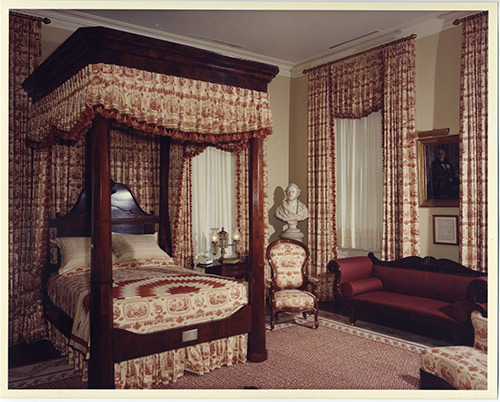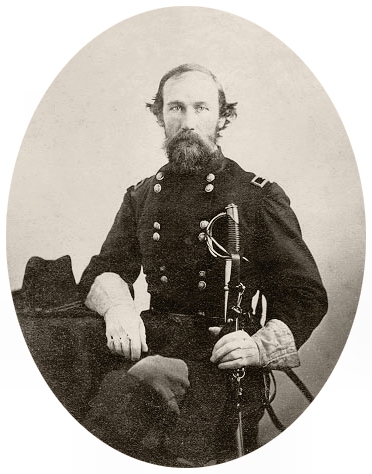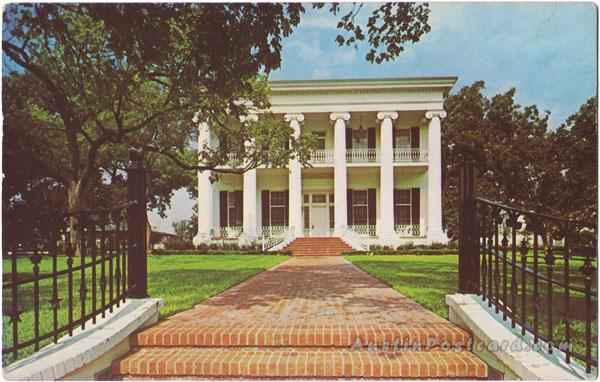Texas Governor's Mansion: A Timeline
/https://static.texastribune.org/media/images/Mansion-Card.jpg)
As Gov. Rick Perry and First Lady Anita Perry prepare to move back into the Governor’s Mansion years after an arsonist nearly destroyed it, take a look back at the building’s 156-year history — from its more mischievous residents to its modern day appliances.
1854: A Suitable Residence

The Legislature appropriates $14,500 for construction of a "suitable residence" for the governor. The contract is awarded to Austin master builder Abner Cook, who adapted the popular Greek Revival style of architecture to the frontier.
Photo courtesy of Texas State Library & Archives Commission
1856: Construction of the Mansion Complete
Texas' fifth governor, Elisha Marshall Pease (in office from 1853-1857), moves into the mansion with his family. Obtaining appropriate furnishings prove difficult and costly. The Legislature's $2,500 appropriation proves inadequate, so the Peases have to use their own furniture. Some of the bedrooms remain unfurnished.
Photo courtesy of Texas State Library & Archives Commission
1860: Sam Houston's Bed
Sam Houston (governor from 1859-1861) orders a massive mahogany four-poster bed to accommodate his wide frame. It cost $30 at the time and is now located in the southeast bedroom.
Photo courtesy of Texas State Library & Archives Commission
1871: Davis Gets a Toilet
The Edmund J. Davis administration installs the first indoor toilet in the mansion. Davis (in office 1870-1874) supported Houston in his stand against secession and, like Houston, refused to take an oath to the Confederacy. In 1862, he left Texas to avoid conscription into the Confederate Army and organized a Union cavalry regiment. He became governor in 1869, with one of the most controversial gubernatorial elections in Texas history: Davis, a Republican, was a favorite of the military, and troops stationed at the polls prevented many Democrats from voting.
Photo courtesy of Texas State Library & Archives Commission
1882: Running Water
Gov. Oran M. Roberts’ administration installs running water in the mansion. Unlike Houston and Davis before him, Roberts (in office 1879-1883) supported the pro-Confederate faction and fought briefly for the Confederate Army. In 1883, the University of Texas opened in Austin, where he taught law after his term ended.
Photo courtesy of Texas State Library & Archives Commission
1883: Ireland's Phone

Gov. John Ireland’s administration installs the first telephone in the mansion. Ireland (in office 1883-1887) also refused to sign a contract to rebuild the state Capitol unless it would be made of native Texas stone. Construction began in 1885, while Ireland was governor.
Photo courtesy of Texas State Library & Archives Commission
1891: A Hogg in the Mansion
James Stephen Hogg (in office from 1891-1895) was Texas’ first native-born governor. Hogg’s four children liked to slide down the sweeping stair rail, but after Hogg’s youngest son fell off, Hogg hammered tacks down the banister and ended the fun. Visitors can still see the filled nail holes.
Photo courtesy of Texas State Library & Archives Commission
1900: Let There Be Light
Electricity is installed in the mansion under Gov. Joseph D. Sayers (in office from 1899-1903). In 1901 the newly decorated mansion received Texas’ first presidential visitor, William McKinley. Anger over the Civil War still ran high in Texas. Sayers, a Confederate veteran, and McKinley, a former Union officer, set an example of reconciliation with a state dinner in the mansion’s dining room.
Photo courtesy of Texas State Library & Archives Commission
1914: Colquitt Lays It Out
With repairs and additions to the mansion during Gov. Oscar Colquitt’s term (1911-1915), the mansion’s basic floor plan came to resemble the mansion’s current layout.
Photo courtesy of Texas State Library & Archives Commission
1925: "Me for Ma"

Miriam Amanda Wallace “Ma” Ferguson is elected the first female governor of Texas.
Photo courtesy of Texas State Library & Archives Commission
1938: Popular Pappy
Popular for his country music radio show, W. Lee “Pappy” O’Daniel wins the gubernatorial election by a landslide in 1938. Less than qualified for the governorship, he proves to be a disappointment as a leader but remains popular through his radio show.
Photo courtesy of Texas State Library & Archives Commission
1952: No More "Shivers"

Central heating and air conditioning are installed during Gov. Allan Shivers’ term (1949-1957). Shivers also brought the first television set to the mansion two years later. Before his election as governor in 1946, Shivers fought in World War II, serving in North Africa, Italy, France and Germany. Shivers served as governor for more than seven years, making him Texas’ longest-serving governor until Gov. Rick Perry broke that record. Shivers is most famous for his insistence that state, rather than federal, authority extended over off-shore drilling operations in Texas, known as the “Tidelands” issue. He broke with the Democratic Party over the matter and supported Republican presidential candidate Dwight D. Eisenhower in 1952. Accused of disloyalty to the Democratic Party, he lost popularity in his last years as governor — and wasn’t helped by his opposition to Brown v. Board of Education, which legally ended segregation.
Photo courtesy of Texas State Library & Archives Commission
1963: Connally Wounded

On Nov. 22, Gov. John Connally (in office 1963-1969) and President John F. Kennedy are shot while traveling through Dallas in a presidential motorcade. Connally recuperates from the wounds in the Governor’s Mansion. Connally fought in the Pacific Theater in WWII. In April 1945, aboard the U.S.S. Essex, he endured 52 consecutive hours of Japanese kamikaze attacks.
Photo courtesy of Texas State Library & Archives Commission
1979: Little Help from Some Friends
The Legislature appropriates $1 million for a complete structural restoration, and the Friends of the Governor's Mansion, a nonprofit organization, raises an additional $3 million in private donations to refurbish the interior. Repairs are completed in 1982.
Photo courtesy of Austin Postcards
1991: Ann and the Queen

Ann Richards, the second female governor of Texas, receives Queen Elizabeth II in the Governor’s Mansion.
Photo courtesy of Texas State Library & Archives Commission
2007: Mansion Maintenance
The mansion is closed for an extensive maintenance project, and numerous antiques are removed and put in storage.
Photo courtesy J. Stephen Conn
2008: Arson
The mansion nearly goes up in smoke when an unknown arsonist tosses a Molotov cocktail on the front porch. Though the roof and front windows are destroyed during the blaze, most of the building — including the elaborate ceiling cornices and pine wood subflooring — survive. The Legislature appropriates $21.5 million for the mansion restoration, and private donors chip in another $3.5 million.
Photo courtesy the Office of the Governor
2011: Mansion Restoration
Restoration of the mansion nears completion and members of the press are allowed in to see the progress.
Photo by Todd Wiseman, The Texas Tribune
2012: Return of the Perrys
Perry and his wife are preparing to move back into the Governor’s Mansion in 2012.
Pool photo by Rodolfo Gonzalez, American-Statesman
Texas Tribune donors or members may be quoted or mentioned in our stories, or may be the subject of them. For a complete list of contributors, click here.
Information about the authors
Learn about The Texas Tribune’s policies, including our partnership with The Trust Project to increase transparency in news.













/https://static.texastribune.org/media/profiles/wiseman-todd-2.JPG)